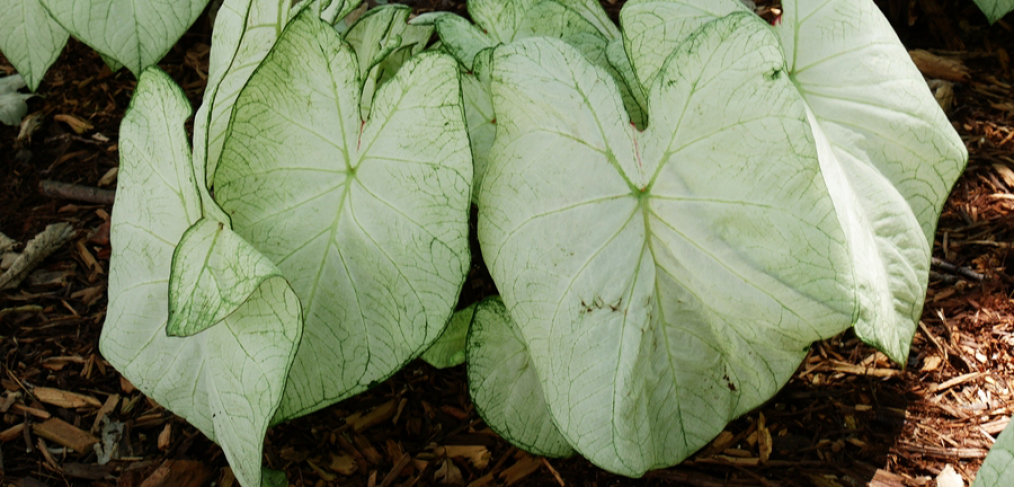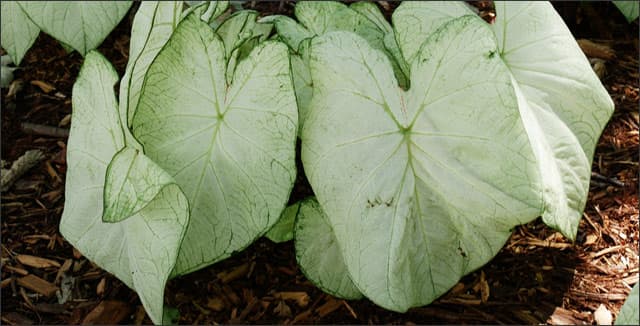
Moonlight Caladium: Exotic Leafy Plants to Grow Indoors Or Out

Do you ever think about how different plants evoke the places from which they originate? Caladium is one of those plants.
Originating in the heart of South America, right along the banks of the Amazon River, these guys are showstoppers with their brightly-colored, paper-thin foliage.
The translucence of the leaves is what makes them so luminous, because the light shines through, making all the colors and markings stand out. Caladium comes in pink, white, red, and green in all kinds of patterns and hues.
Caladium is related to the elephant ear plant. They are both of the family Araceae and known by the common name elephant ear for their shape, along with Alocasia, Colocasia, and Xanthosoma.
There are seven species of caladium, all indigenous to Brazil and the surrounding areas of South and Central America.
In their native habitat, they grow in the open spaces of tropical forests and on the banks of streams.
No matter where you plant them, caladium, like their other elephant ear cousins, die off and go dormant for several months of every year. However, if you take special care of the tubers, you can keep your caladiums for many years.
Keeping caladium in cold northern climates may require some fiddling every year. However, it’s usually worth it for the bright colors of the foliage that rival any flower, and which last from spring until late summer.
Unless you live in the few tropical regions of the U.S., you may still have to take special care of your caladiums, as they can tolerate no frost whatsoever. It will kill your bulbs.
The other very important consideration is that all parts of the caladium plant are poisonous. It may not be the right plant for you if you have pets or children.
Moonlight Caladium Variety
Do you follow plants on social media? I was recently captivated by a picture I saw on Pinterest of potted moonlight caladium sitting in a window and backlit by sunlight.
The translucent white leaves with a light green border and spine are a real showstopper.
Plant them as a backdrop for colorful flowers, in clumps around a pond or water feature, or in a pot inside to brighten up the indoors.
You are sure to get compliments. Moonlight or Florida moonlight is one of the many cultivars of caladium. Many cultivars aren’t sold under any name as there are so many hybrids.
However, this cultivar was named for its creator: the University of Florida in 2002. Additionally, it’s gaining popularity.
Growing Moonlight Caladium
Given the right conditions, caladium will thrive and grow up to two feet tall in pleasing round clumps.
The rules are the same whether you grow them outside or inside. Be aware that you will have to provide what the plant needs indoors; mainly, humidity.
Caladium thrives on humidity, and the typical home with an air-conditioned interior is arid. It will not do well if you don’t take precautions against this.
How To Help Your Moonlight Caladium Thrive
How can you provide proper humidity for your plant without sacrificing your own comfort, you ask?
Make sure to keep it away from HVAC vents, for one. They are very drying. You can mist regularly, and you can put it on a saucer with a thin layer of pebbles and water.
Do you know how this provides humidity? As the water from the saucer evaporates, it creates a small pocket of moisture right around the plant.
Other caladium must-haves:
- Shade
- Good drainage
- The right temperature
- Fertilizer
Shade
Midday sun will scorch your caladiums, so whether indoors or out, look for a Northern or Eastern exposure and partial to full shade.
You can plant them under a tree, and they will do well. Some caladium varieties can tolerate sun, but moonlight loves the shade.
Drainage
For outdoor planting, don’t put caladium in a spot that puddles after rain. Make a mounded area for better drainage and keep the bulbs moist but not wet.
When they begin to grow, it’s best to keep them moist at all times. For indoor use, make sure you have a well-draining pot and potting mix.
Temperature
Caladium bulbs begin to bloom when temperatures are consistently above 70 degrees Fahrenheit.
They cannot tolerate any frost whatsoever. It will kill the leaves and the bulbs.
When planting outdoors, make sure not to plant until the soil has warmed up and all danger of frost has passed.
Fertilizer
Caladiums need fertilizer in their growing season, which is spring to late summer.
If you have caladiums that are still surviving inside during late fall and winter, only water them when the soil dries out completely and never fertilize.
You can use bone meal, liquid fertilizer, or slow-release pellets.
How to Plant Moonlight Caladium
If you are planning to use these beauties in your landscape, you want to plant after the soil temperature reaches at least 65 degrees Fahrenheit.
In some locations, the last frost is very late in the year, so you can always start your caladium indoors and move them once they’re well established.
Make sure they’re in a warm, moist place with high humidity inside.
As with other bulbs, plant them smooth side down and eye side up. If you mistakenly plant them upside down, they will still sprout, but they may not be as happy.
Cover them with at least half an inch of soil, but up to two inches. Add a bit of bone meal to the hole before planting. Water the bulbs after planting and mulch to preserve the soil’s moisture.
Bigger bulbs give more foliage, and they are sold in different size grades. The bigger bulbs do better, as this is the source of energy for the plant. The bigger they are, the further apart they need to be spaced: small bulbs need 6-8 inches of space, while jumbo bulbs need up to 18 inches of space.
When to Take the Plants Inside
When temperatures outside are consistently in the 60s, it’s time to take your plants inside.
They may live for a while inside, but their pattern is to stop growing for about five months before starting again.
To save bulbs indoors, wait until the last leaf has died before pulling up the tuber and removing the dead leaves.
Let them dry for a few days and then pack them in peat moss for the winter and store in a cool, dry place.
If you have an indoor caladium, over-winter the bulbs in their pot. Stop watering them and set in a cool, dark place while you wait for spring.
Takeaway
Moonlight caladium is one of the most exotic and eerily beautiful plants you can cultivate in your home or garden. The showy leaves will make your neighbors ooh and ah for years to come.



